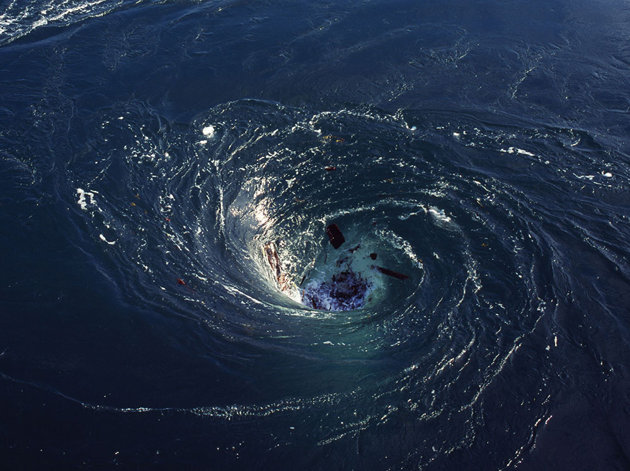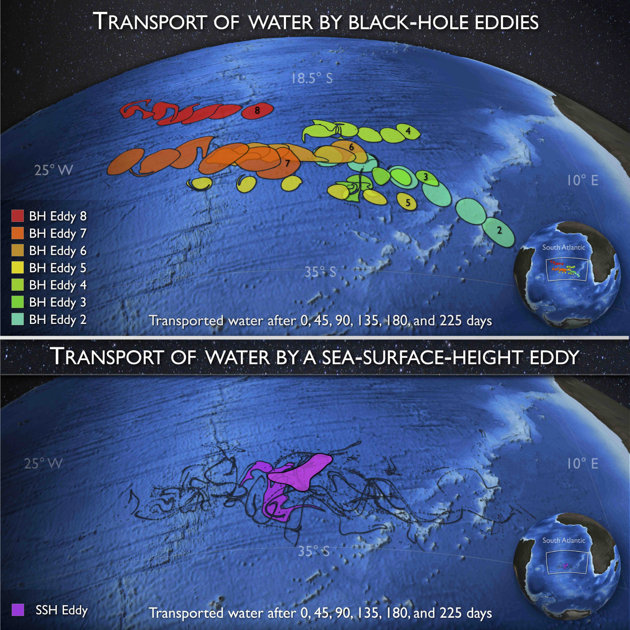It looks like you're using an Ad Blocker.
Please white-list or disable AboveTopSecret.com in your ad-blocking tool.
Thank you.
Some features of ATS will be disabled while you continue to use an ad-blocker.
share:
Satellites have shown two mysterious 'black hole' whirlpools in the South Atlantic ocean - ultra powerful “vortexes” which suck water down into the depths. The whirpools - never witnessed before - would suck down ships, debris and even living creatures, moving 1.3 million cubic metres of water per second.
Link< br />

Imagine coming across one of these bad boys in the middle of the ocean!
I must say that when I read the article, one of the first things that occurred to me was if these "maelstroms" are capable of forming in any of our large oceans, then could this be a possible explanation for the strange disappearances in and around the Bermuda Triangle?
edit on 21/8/2013 by
Argyll because: (no reason given)
edit on 21/8/2013 by Argyll because: (no reason given)
reply to post by Argyll
The Earth is thirsty???
Scary, scary ~ Makes you wonder what's causing this to happen, where the water is going because the water levels are still rising? Right???
The Earth is thirsty???
Scary, scary ~ Makes you wonder what's causing this to happen, where the water is going because the water levels are still rising? Right???
Davy Jones' locker is at the bottom.
edit on 21-8-2013 by Biigs because: (no reason given)
reply to post by DeepVisions
No, the article doesn't say....but considering they move 1.3 million cubic metres of water per second, I'd imagine they must be a fair old size.
Any idea how wide these things are?
No, the article doesn't say....but considering they move 1.3 million cubic metres of water per second, I'd imagine they must be a fair old size.
Cool.
Discovery News
Discovery News
And much like astronomical black holes, oceanic eddies exhibit singularity.
To locate these oceanic black holes, the scientists examined satellite images of the Agulhas Current in the Indian Ocean. The current travels along the east coast of Africa before turning back on itself in a loop. The loop occasionally pinches off and forms eddies that whirl off into the South Atlantic Ocean, remaining intact for more than three months.
The eddies are a coherent island of water in an otherwise turbulent ocean. As such, they “create moving oases for the marine food chain or even impact climate change through their long-range transport of salinity and temperature,” the study states. The eddies will capture any detritus floating nearby and swallow it, thereby transporting oil and garbage. And nothing within leaks out.
Originally posted by rickymouse
I wish my toilet had that good suction.
You need to take smaller bites and chew better when you eat
edit on 21-8-2013 by Biigs because: (no reason given)
Very interesting, I did not know this
link
The singularities, as they have been termed, last for months at a time, moving across the ocean without interference from other currents. Thus they can transport water of different temperatures and salinity to other areas of the ocean, potentially influencing the regional climate.
Haller and Beron-Vera found that the vortices transported water in a north-western direction 30% faster than had previously been reckoned – at a rate equating to 1.3 million cubic metres of water per second. In addition, the maelstroms were found to occur four times deeper in the ocean than previously estimated; the study found examples as deep as 2000m below the surface.
link
Originally posted by Biigs
Originally posted by rickymouse
I wish my toilet had that good suction.
You need to take smaller bites and chew better when you eatedit on 21-8-2013 by Biigs because: (no reason given)
Hahaha!
2
magnetic centrifugal force being generated by the earth rising up through the sea.
or a sinkhole/cave/pyramid/large pocket being filled with water?
or a sinkhole/cave/pyramid/large pocket being filled with water?
reply to post by filledcup
Can't see it to be honest as they move quite a distance

magnetic centrifugal force being generated by the earth rising up through the sea.
or a sinkhole/cave/pyramid/large pocket being filled with water?
Can't see it to be honest as they move quite a distance
The singularities, as they have been termed, last for months at a time, moving across the ocean without interference from other currents.

Stupid question Alert!
If we have anyone experienced enough to answer? Can these be spotted on Google Earth? I'm wondering if it's even worth playing around with when we're all bored to see if there might be others out there which their computers didn't hit on. After all, I know, computers never ever miss anything, but who knows, maybe they didn't scan a part yet.
This would be really interesting to find, I'm thinking. I'm just not going to even bother trying if that thing is 50 feet across. Ugh.... I'd be blind and seeing blue on my eyelids for life before I found one at the resolution/zoom that would require. lol
If we have anyone experienced enough to answer? Can these be spotted on Google Earth? I'm wondering if it's even worth playing around with when we're all bored to see if there might be others out there which their computers didn't hit on. After all, I know, computers never ever miss anything, but who knows, maybe they didn't scan a part yet.
This would be really interesting to find, I'm thinking. I'm just not going to even bother trying if that thing is 50 feet across. Ugh.... I'd be blind and seeing blue on my eyelids for life before I found one at the resolution/zoom that would require. lol
edit on 21-8-2013 by Wrabbit2000
because: (no reason given)
Originally posted by Biigs
Originally posted by rickymouse
I wish my toilet had that good suction.
You need to take smaller bites and chew better when you eatedit on 21-8-2013 by Biigs because: (no reason given)
Ha ha ha, I knew I was doing something wrong, lol. What we are seeing is aliens making energy using what appears to be natural phenomenon, lol.
Seriously though imagine the energy we could generate with a few of these.
The Bot
Originally posted by Argyll
reply to post by filledcup
magnetic centrifugal force being generated by the earth rising up through the sea.
or a sinkhole/cave/pyramid/large pocket being filled with water?
Can't see it to be honest as they move quite a distance
The singularities, as they have been termed, last for months at a time, moving across the ocean without interference from other currents.
ahh ok didnt see these images.. but the magnetic force can move.. just like a tornado does.. it can travel.. spinning the water with it as it moves.
This is actually quite cool. Despite the fact that Humans have been sailing the oceans since we could build a raft we never saw this. I suspect
those that did see were not around afterwards to report on it. If I remember there some myths and legends about the sea opening up a giant whirlpool
that sucked down ships, And here it is!
Link to Wikipedia
In Greek mythology, Charybdis (or Kharybdis) was once a beautiful naiad and the daughter of Poseidon and Gaia. She assumes the form of a huge bladder of a creature whose face is all mouth and whose arms and legs are flippers.[citation needed] She swallows a huge amount of water three times a day, before belching it back out again, creating large whirlpools capable of dragging a ship underwater. In some variations of the story, Charybdis is simply a large whirlpool instead of a sea monster. Once a lovely maiden, Charybdis was loyal to her father in his endless feud with Zeus. She rode the hungry tides after Poseidon stirred up a storm, directing them onto beaches, destroying entire villages, submerging fields and drowning forests, claiming all in her path for the sea. She claimed so much land for her father's kingdom that Zeus became enraged and changed her into a monster. In mythology Charybdis lies on one side of a narrow channel. Opposite her is Scylla, another sea-monster. The sides of the strait are within an arrow shot of each other, and sailors attempting to avoid one of them will come in reach of the other. 'Between Scylla and Charybdis' thus means to having to choose between two dangers, either of which brings harm. The theoretical size of Charybdis remains unknown, yet in order to consume Greek ships the whirlpool can be estimated to about 75 feet across. Charybdis has been associated with the Strait of Messina, off the coast of Sicily and opposite a rock on the mainland identified with Scylla.[1] Were Charybdis to be located in the Strait of Messina it would in fact have the size to accommodate the whirlpool. A whirlpool does exist there, caused by currents meeting, but it is seldom dangerous.
Link to Wikipedia
Ok, maybe its just me but that doesn't look any bigger than the whirlpools i see when I
Pull my speedboat away for the marina's breakwater.
Kinda hard to get perspective with nothing of know dimensions in the pic.
Pull my speedboat away for the marina's breakwater.
Kinda hard to get perspective with nothing of know dimensions in the pic.
new topics
-
Trump could make a peaceful American Revolution
US Political Madness: 2 hours ago -
Trump Presidential Transition Team will not use GSA or Government entities to come to DC
US Political Madness: 3 hours ago -
Mind Blowing Cave under someones land
Fragile Earth: 3 hours ago -
The Party of Peace - Trump Cabinet Picks Targeted with Death Threats
US Political Madness: 4 hours ago -
V.P. Kamala Harris releases a video and nobody understands why
US Political Madness: 7 hours ago
top topics
-
D.B. Cooper mystery may be solved
General Conspiracies: 12 hours ago, 21 flags -
V.P. Kamala Harris releases a video and nobody understands why
US Political Madness: 7 hours ago, 16 flags -
Mind Blowing Cave under someones land
Fragile Earth: 3 hours ago, 12 flags -
The Party of Peace - Trump Cabinet Picks Targeted with Death Threats
US Political Madness: 4 hours ago, 11 flags -
Trump Presidential Transition Team will not use GSA or Government entities to come to DC
US Political Madness: 3 hours ago, 9 flags -
Trump could make a peaceful American Revolution
US Political Madness: 2 hours ago, 7 flags
active topics
-
I thought Trump was the existential threat?
World War Three • 105 • : Xtrozero -
V.P. Kamala Harris releases a video and nobody understands why
US Political Madness • 54 • : tinkerbell99 -
Trump Presidential Transition Team will not use GSA or Government entities to come to DC
US Political Madness • 7 • : WeMustCare -
Trump could make a peaceful American Revolution
US Political Madness • 3 • : NorthOS -
The Party of Peace - Trump Cabinet Picks Targeted with Death Threats
US Political Madness • 8 • : DontTreadOnMe -
Mind Blowing Cave under someones land
Fragile Earth • 13 • : CarlLaFong -
President-Elect DONALD TRUMP's 2nd-Term Administration Takes Shape.
Political Ideology • 254 • : WeMustCare -
Post A Funny (T&C Friendly) Pic Part IV: The LOL awakens!
General Chit Chat • 7836 • : underpass61 -
Petition Calling for General Election at 564,016 and rising Fast
Political Issues • 105 • : onestonemonkey -
-@TH3WH17ERABB17- -Q- ---TIME TO SHOW THE WORLD--- -Part- --44--
Dissecting Disinformation • 3388 • : Thoughtful3
